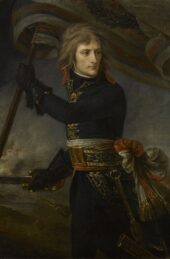Napoleon’s Birthday
Napoleon was born on 15 August, 1769. Under the Gregorian calendar this date was a holiday celebrating the Ascension of the Virgin Mary. The French Revolutionaries introduced a new calendar on 5 October, 1793, backdated to 22 September, 1792, the first day of the First Republic. The Republican calendar weeks were ten days long and each of the days was named after a plant, animal or tool used by agricultural labourers. One of the designers of the new calendar explained: ‘We could not go on reckoning the years during which we were oppressed by kings as part of our lifetime. Every page of the old calendar was soiled by the prejudices and falsehoods of the throne and the church.’ Under the new calendar, Napoleon’s birthday fell on 28 Thermidor, the day of the wolf.
As Napoleon’s power grew, so too did his birthday celebrations. Following the Peace of Amiens in 1802, his tenure as First Consul was extended, first for a further ten years, then for life. Aside from General Carnot, who declared ‘I will vote against the re-establishment of monarchy’, the tribunate voted unanimously in favour of this lifetime extension. A plebiscite on 14 Thermidor (2 August) was also overwhelmingly in favour. Napoleon’s birthday that year was celebrated by a Te Deum in Notre-Dame marking the ‘Birthday of the Consul for Life’.
On 1 January, 1806, Napoleon suppressed the Republican calendar and ordered a return to the Gregorian. For all its beauty, the Republican calendar was unpopular and unwieldy: every year began on a different day to coincide with the autumn equinox. Later that year, 15 August became a new public holiday celebrating Saint Napoleon. The saint in question was not the emperor himself. It was Saint Neopolus, an Egyptian martyr, tortured to death in Alexandria during the reign of the Roman Emperor Diocletian. Saint Neopolus was also called Napoleon and the celebration of his feast day on the emperor’s birthday was no accident. The Alexandria connection was also no coincidence. Somehow Napoleon had managed to present his bloody campaign in Egypt and Syria (1789-1801) as a triumph of Enlightenment values: his first but not his last propaganda miracle.
Year on year, the celebrations of Napoleon’s birthday became more spectacular. On 15 August, 1810, when he turned forty-one, Napoleon did not attend the unveiling of the column in his honour in the Place de Vendôme. There had been a French plan to move Trajan’s Column from Rome to Paris, but when this proved impossible, a replica was commissioned, a celebration of the Battle of Austerlitz, made from metal melted down from 1,200 captured Austrian cannon. Out of respect for his second wife Marie Louise, daughter of Francis II, Holy Roman Emperor and Emperor of Austria, Napoleon kept his distance from the unveiling. Afterwards, he was displeased to discover that he was represented at the top of the new column, which was 7.6 metres taller than the original, wearing a toga. He worried that this was ridiculous. Nor did he like the four eagles, perched in swags of foliage, at the corners of the base of the monument, but the sculptor Canova assured him these were accurately copied from Trajan’s Column.
In Rome, the youngest prefect in the Empire, Camille de Tournon, hoped work on Jardin du Grand César could begin on Napoleon’s forty-second birthday in 1811. But Tournon was away from Rome at the time and the digging did not start until September. Back in Paris, Napoleon was planning the construction of a huge palace for his son, known as the King of Rome, on the banks of the river Seine. The first stone was laid on 15 August, 1812, the same day as the attack on Smolensk, a walled city 360 kilometres south-west of Moscow.
The French razed Smolensk. Over 80 per cent of its buildings were destroyed by artillery fire and almost all the inhabitants fled. Thousands of soldiers on both sides died. The exact numbers are disputed, but Napoleon tried to claim French losses were as low as seven hundred. He sent back triumphant bulletins and letters to Marie Louise, but the destruction of Smolensk left him without badly needed supplies for his army. By the time of his birthday the following year, it was clear his power was declining. His architects noticed that progress on the grandiose palace for the King of Rome was faltering. Napoleon decided to celebrate his birthday five days early at Dresden, correctly anticipating the resumption of hostilities with the Prussian army under the command of General Blücher.
Napoleon’s birthday in 1814 was the first he spent in exile. His mother arrived on Elba earlier in August, and was there to celebrate with him on the 15th. The following year he spent his birthday at sea on board HMS Northumberland, on the way to the South Atlantic island of St. Helena, where he marked the remaining five birthdays he had until he died, aged fifty-one in 1821.
Since his death there have always been public and private celebrations of Napoleon’s birthday. A friend of mine told me that her father, a serious Italian collector of Napoleonic memorabilia, always opened a bottle of the Emperor’s favourite Chambertin wine in his honour on 15 August. Allegedly Napoleon claimed that “nothing makes the future look so rosy as to contemplate it through a glass of Chambertin.” Love him or hate him, here’s to Napoleon on his birthday!
Ruth Scurr is the author of Napoleon: A Life in Gardens & Shadows.







